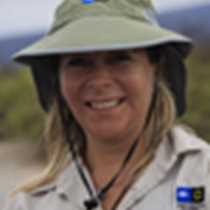Isabela and Fernandina Islands
Our ship has sailed all through the night to take us to the remote western islands of the archipelago. We had a beautiful and fresh early morning meeting at the upper decks of the Islander to scan the Pacific waters looking for marine mammals to appear…and “there she blows!” Our Expedition Leader, along with one of our guests, saw a big blow on the horizon, most likely a blue whale by the size of its blow in the distance. She might have been busy on her way to the depths looking for food, and we never saw her back on the surface. It was for sure an intense search!
Our first morning outing was a Zodiac ride along the shores of the eroded walls of Ecuador volcano; at the base of the cliffs we saw our first flightless cormorants and Galápagos penguins. Many sea turtles, sea lions, blue-footed boobies, marine iguanas and Sally Lightfoot crabs accompanied us on the shoreline. Then we went further off shore looking for the Mola mola or sun fish. We found a huge one, about fifteen hundred pounds. This big, oval fish was about six feet across and seven feet from the tip of its dorsal fin to the tip of its anal fin. We spent some thirty minutes observing it feed. Once back onboard, we geared up to go to one of the best snorkeling sites. This morning we snorkeled at Punta Vicente Roca, a sea turtle garden, where dozens of turtles surrounded us and sea lions, penguins and flightless cormorants also accompanied us.
Our lunch today was interrupted by the best of surprises; whale spouts were sighted and, as we approached, we were able to identify the whales. We observed one small blue whale and at least six Bryde’s whales which spouted and dove repeatedly, to everybody’s delight. The whales stayed around the Islander for more than an hour, and then we reluctantly continued on our course.
The walk in the afternoon at Punta Espinoza on Fernandina Island was highlighted by hundreds of big fat marine iguanas, a hunting hawk and nesting flightless cormorants. All this, in just one day!
Our ship has sailed all through the night to take us to the remote western islands of the archipelago. We had a beautiful and fresh early morning meeting at the upper decks of the Islander to scan the Pacific waters looking for marine mammals to appear…and “there she blows!” Our Expedition Leader, along with one of our guests, saw a big blow on the horizon, most likely a blue whale by the size of its blow in the distance. She might have been busy on her way to the depths looking for food, and we never saw her back on the surface. It was for sure an intense search!
Our first morning outing was a Zodiac ride along the shores of the eroded walls of Ecuador volcano; at the base of the cliffs we saw our first flightless cormorants and Galápagos penguins. Many sea turtles, sea lions, blue-footed boobies, marine iguanas and Sally Lightfoot crabs accompanied us on the shoreline. Then we went further off shore looking for the Mola mola or sun fish. We found a huge one, about fifteen hundred pounds. This big, oval fish was about six feet across and seven feet from the tip of its dorsal fin to the tip of its anal fin. We spent some thirty minutes observing it feed. Once back onboard, we geared up to go to one of the best snorkeling sites. This morning we snorkeled at Punta Vicente Roca, a sea turtle garden, where dozens of turtles surrounded us and sea lions, penguins and flightless cormorants also accompanied us.
Our lunch today was interrupted by the best of surprises; whale spouts were sighted and, as we approached, we were able to identify the whales. We observed one small blue whale and at least six Bryde’s whales which spouted and dove repeatedly, to everybody’s delight. The whales stayed around the Islander for more than an hour, and then we reluctantly continued on our course.
The walk in the afternoon at Punta Espinoza on Fernandina Island was highlighted by hundreds of big fat marine iguanas, a hunting hawk and nesting flightless cormorants. All this, in just one day!




